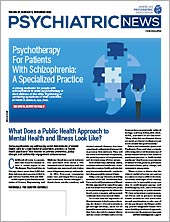Soon after the COVID-19 pandemic started, health care professionals started thinking about the “pandemic after the pandemic,” said Sejal Shah, M.D., the division chief of medical psychiatry and associate vice chair for clinical consultation services at Brigham and Women’s Hospital. “We were already seeing an uptick in the patients we saw with acute psychiatric illnesses,” said Shah, who is also the immediate past chair of APA’s Council on Consultation-Liaison Psychiatry. “We assumed things would get worse as more people experienced the pandemic.”
Now, data back up those early suspicions. A study published in August in The Lancet Psychiatry found that while patients with COVID-19 are at an increased risk of depression and anxiety, this increased risk typically subsides within two months. However, patients may have an elevated risk for developing other psychiatric and neurological conditions, such as psychosis, brain fog, and seizures, for up to two years after their infections.
“The findings shed new light on the longer-term mental and brain health consequences for people following COVID-19 infection,” the study’s lead author Max Taquet, B.M. B.Ch., Ph.D., research fellow with the Oxford Health Biomedical Research Centre and National Institute for Health and Care Research Academic Clinical Fellow, said in a statement. “The results have implications for patients and health services and highlight the need for more research to understand why this happens after COVID-19 and what can be done to prevent these disorders from occurring or treat them when they do.”
Taquet and colleagues used data from the TriNetX electronic health record network, an international network of de-identified health care records from approximately 89 million patients (mostly from the United States, but also from Australia, Bulgaria, India, Malaysia, Spain, Taiwan, and the United Kingdom). The authors identified patients of any age who were diagnosed with COVID-19 between January 20, 2020, and April 13, 2022. These patients were matched with a cohort of patients diagnosed with any other respiratory infection.
The authors compared the risk of 14 neurological and psychiatric diagnoses for up to two years after infection among patients in the COVID-19 group with those in the other respiratory infection group. These diagnoses included anxiety disorder, mood disorder, psychotic disorder, insomnia, cognitive deficit (or brain fog), dementia, epilepsy or seizures, and ischemic stroke. To investigate the impact of different variants of COVID-19, the authors also compared patients diagnosed directly before and after the emergence of the alpha, delta, and omicron variants. The data were analyzed according to the patients’ ages: children (under 18 years), adults (18 to 64 years), and older adults (65 years and older).
Nearly 1.3 million patients with confirmed COVID-19 diagnoses were included in the study. Compared with adults diagnosed with any other respiratory disease (control group), those who had had COVID-19 had a higher risk of brain fog (640 cases per 10,000 people in the COVID-19 group vs. 550 cases per 10,000 people in the control group) and muscle disease (44 cases per 10,000 people in the COVID-19 group vs. 32 cases per 10,000 people in the control group). In older adults who had had COVID-19, there was a higher occurrence of brain fog (1,540 cases per 10,000 people in the COVID-19 group vs. 1,230 cases per 10,000 people in the control group), dementia (450 cases per 10,000 people in the COVID-19 group vs. 330 cases per 10,000 people for dementia in the control group), and psychotic disorder (85 cases per 10,000 people in the COVID-19 group vs. 60 cases per 10,000 for psychotic disorder in the control group).
Among adults, the risk of mood or anxiety disorder diagnoses initially increased immediately after the COVID-19 infection but returned to the same risk level as other respiratory infections after 43 days for mood disorders and 58 days for anxiety disorders. After two years, there was no difference in the incidence of mood and anxiety disorders between the COVID-19 group and the group of patients diagnosed with any other respiratory infection.
Children were not at greater risk for mood or anxiety disorders following a COVID-19 diagnosis compared with children diagnosed with other respiratory infections. In the two years following COVID-19, however, children were more likely to be diagnosed with seizures (260 cases per 10,000 children for the COVID-19 group vs. 130 cases per 10,000 for the control group) and psychotic disorders (18 cases per 10,000 children for the COVID-19 group vs. 6 cases per 10,000 for the control group).
Shah pointed to the need for more research to better understand the elevated risks for patients. “Are the episodes of anxiety, depression, psychoses, and neurological disorders we’re seeing after COVID a different breed than what we’re used to?” she said. “Are these illnesses going to require different treatments, and do we have the resources we need to care for these patients?”
“We need to have an explicit focus on the integration of mental and physical health for these patients, moving away from a dualistic view of mind and body, and use interventions that can help with symptoms and functioning in both domains,” said Kathleen Sheehan, M.D., D.Phil., an assistant professor of psychiatry at the University of Toronto and clinician-investigator at the University Health Network in Toronto. Sheehan was not involved in this study.
Taquet and colleagues also found that the delta variant was associated with significantly higher six-month risks of numerous disorders compared with individuals diagnosed with COVID-19 in the period just before delta emerged. Delta increased the risk of anxiety by 10%, insomnia by 19%, brain fog by 38%, epilepsy or seizures by 26%, and ischemic strokes by 27%. Delta was associated with a 40% lower risk of dementia, however. The risks during the omicron wave were similar to those when delta was the dominant variant.
That later variants increase the risk for psychiatric and neurological diseases is extremely worrisome, Shah said. “I’m concerned about the burden on the health care system,” she said.
Sheehan noted that the pandemic has amplified the already existing cracks and gaps in the health care system. “Hospitals have been short-staffed due to work illness and exposures, and there are reports of high numbers of health care providers leaving their professions,” she said. “We need a functioning, and preferably high-functioning, health care system to manage the longer-term impacts of COVID. This includes health care institutions dedicating resources to ensure that they have a healthy provider workforce. Similar to caring for patients, this requires system-level change.”
The study was funded by the National Institute for Health and Care Research Oxford Health Biomedical Research Centre, The Wolfson Foundation, and MQ Mental Health Research. ■


